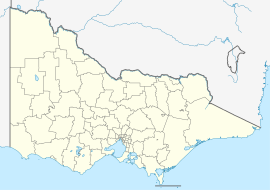Bendigo
| Bendigo Victoria | |||||||||
|---|---|---|---|---|---|---|---|---|---|
 Bendigo city centre | |||||||||
| Coordinates | 36°45′0″S144°16′0″E/ 36.75000°S 144.26667°E | ||||||||
| Population | 103,034 (2021)[1](19th) | ||||||||
| • Density | 358.50/km2(928.52/sq mi) | ||||||||
| Established | 1851 | ||||||||
| Postcode(s) | 3550[2] | ||||||||
| Elevation | 213 m (699 ft) | ||||||||
| Area | 287.4 km2(111.0 sq mi)[3](2016 urban) | ||||||||
| Time zone | AEST(UTC+10) | ||||||||
| • Summer (DST) | AEST(UTC+11) | ||||||||
| Location | |||||||||
| LGA(s) | City of Greater Bendigo | ||||||||
| Region | Loddon Mallee | ||||||||
| County | Bendigo | ||||||||
| State electorate(s) | |||||||||
| Federal division(s) | Bendigo | ||||||||
| |||||||||
Bendigo(/ˈbɛndɪɡoʊ/BEN-dig-oh) is a city in north-centralVictoria,Australia,located in theBendigo Valleynear the geographical centre of the state[4]and approximately 150 kilometres (93 mi) north-west ofMelbourne,the state capital.
As of 2022, Bendigo has a population of 103,818 making it Australia's 19th-largestcity by population.[5]Bendigo is the fourth-largest inland city in Australia and the fourth-most populous city inVictoria.
Bendigo is administered by theCity of Greater Bendigo,formerly theCity of Bendigo.The council area encompasses roughly 3,000 square kilometres,[6]the city is surrounded by smaller towns such asCastlemaineandHeathcote.
Thetraditional ownersof the area are theDja Dja Wurrung(Djaara) people.[7]The discovery of gold onBendigo Creekin 1851 transformed the area from asheep stationinto one of colonial Australia's largestboomtowns.News of the finds intensified theVictorian gold rush,bringing an influx of migrants from around the world, particularly Europe and China. Bendigo became eastern Australia's largest 19th-century gold-mining economy, and the wealth generated during this period is reflected today in the city'sVictorian architecturalheritage. From 1853 until 1891, Bendigo was officially named Sandhurst.
Bendigo's boom period lasted until the early 20th century and after a temporary decline in population and employment, renewed growth occurred from the 1930s as the city consolidated as a manufacturing and regional service centre. Although gold mining continues, recent population growth has been most heavily concentrated in suburban areas. With the completion of theCalder Freewaylinking Melbourne and Bendigo in 2009, and the region's proximity to Melbourne, Bendigo has become one of the fastest-growing regional centres in Victoria.[8]
History
[edit]Indigenous history and European settlement
[edit]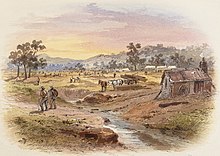
The Traditional Owners of theMount Alexanderarea that includesGreater Bendigoare theDja Dja Wurrung(Djaara) people. They exploited the rich local hunting grounds from which they were displaced by the arrival bywhite settlers,who established the first of many vast sheep runs in 1837. The Djadjawurrung peoples experienced two waves of settlement and dispossession: from the south from 1837 and from the north from 1845.[9]The marked decrease in Dja Dja Wurrung population was also due to the arrival of non-indigenous animals; they use their noses to ‘root up’ the nutritiousmoon-nar tuber(yam daisy); after just a year it was noticed the plant was becoming scarce.[10]
Squatters in the area included: Donald Campbell at Bullock Creek inRavenswood;J & R Bakewell to the north of Bendigo; Heap & Gryce to the north-west; Archibald McDougall to the west; Joseph Raleigh and James Robinson along theCampaspe Riverto the south; and Thomas, Jones, and William Barnett to the east.[11][12]TheRavenswood"Mount Alexander North run", occupied from c.1840 by Donald Campbell, was acquired by brothers Stewart and Robert Gibson in 1848, with Frederick Fenton later replacing one of the Gibson brothers. After the discovery of gold in 1851, Fenton sold provisions to the miners and agisted their horses. Becoming the sole owner of theRavenswoodrun in 1857, Fenton built its substantial homestead.[13]
Gold was officially discovered on Bendigo Creek at the north-eastern boundary of theRavenswoodrun,[14]earlier known as the Mount Alexander North run, in October 1851. The creek had been named "Bendigo Creek" after a local shepherd and employee of the Mount Alexander North run nicknamed for the English bare-knuckle prizefighterWilliam Abednego "Bendigo" Thompson.The area was transformed in less than a year as tens of thousands of people arrived during the great gold rush in 1852.
Widespread gold mining caused environmental devastation and permanent damage in the district, decimating and displacing the Dja Dja Wurrung[15]and destroying the infrastructure they created over generations to maximise seasonal drainage patterns; the channels and weirs they built out of timber stakes, to slow receding summer flows, were wrecked; water holes where the people gathered in smaller groups during periods of scarce rainfall and from which they transported water in skin bags when moving, were muddied, polluted and drained; the soaks they had dug between banks into sandy sediment to tap into the water table were likewise obliterated. Some of their waterholes in rock platforms of creeks that they found or enlarged, then covered with slabs to protect them from animals, may still remain, unidentified.[16][15][17]
Gold mining boom
[edit]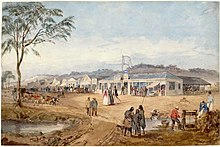
Gold was officially discovered in the area in October 1851,[14]just after the other significant goldfields in neighbouringCastlemaine,from where many diggers migrated, bringing the total population to 40,000 in less than a year. Many of these diggers were Chinese and their descendants still live in the region.

During 1852, under the direction ofSurveyor General of Victoria,Robert Hoddle,William Swan Urquhart was making a general survey of Mount Alexander and the surrounding ranges, and of the goldfields, and fixed the site of the township of 'Sandhurst', now Bendigo. On 13 July 1852 Hoddle passed on to Urquhart Lieutenant-Governor La Trobe's request for a plan of the Mount Alexander gold workings, and his order that he mark out a reserve at the junction of Golden Gully with Bendigo Creek, and the camp on the west side of the creek below the junction. In late August La Trobe wanted him to report urgently on the best reserves for agriculture in the district. By 26 November he had mapped Bendigo Creek and Myers Creek, and his survey of theBendigo Valleyand environs marked township reserves at Bullock Creek, Ravenswood and Happy Jack where settlement was already taking place. His planGeneral Survey of the Bendigo Goldfields showing the proposed reserves for townships. Drawn by W.S. Urquhart, Melbourne, November 1852recommended sites for national schools, churches, markets and other public purposes reserved from sale.[18]
In 1853, a massive protest was held over the cost of the licence fee for prospectors, though it passed off peacefully, due to good diplomacy by police and miners' leaders. From being a tent city, the boomtown grew rapidly into a major urban centre with many grand public buildings. The municipality became a borough in 1863, officially known asSandhurstuntil 1891, but always unofficially as Bendigo.
The railway had reached Bendigo by 1862, stimulating rapid growth, with flour mills, woollen mills, tanneries, quarries, foundries,eucalyptus oilproduction, food production industries, and timber cutting. When the alluvial gold ran out, extraction of quartz-based gold continued indeep shaftsusing industrial systems.
Selectionin the futurecounty of Bendigo(created in 1869) commenced under the Land Act of 1865, with most settlement occurring around Sandhurst andEaglehawk.
Decline and regeneration
[edit]
Bendigo was declared a city in 1871. Rapid population growth brought a water shortage, partially solved with a new viaduct that harnessed theColiban River. The architectWilliam Charles Vahland(1828–1915) left an important mark on Bendigo during this period. He is credited with the popular cottage design withverandahsdecorated in iron lace, a style that was soon adopted across the state of Victoria. Vahland also designed more than 80 buildings, including theAlexandra Fountain,arguably the most prominent monument in Bendigo, with its granite dolphins, unicorns, nymphs and allegorical figures. Atram networkwas in use by 1890.
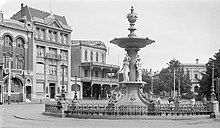

After a temporary drop in population, renewed growth occurred from the 1930s, as the city consolidated as a manufacturing and regional service centre, though gold mining continues.[citation needed]Recent growth has been most heavily concentrated in areas such as Epsom, Kangaroo Flat, Strathdale, and Strathfieldsaye.[citation needed]
On 28 March 2013, theDja Dja Wurrungpeople were formally recognised as thetraditional ownersfor part of Central Victoria, including the land on which the City of Greater Bendigo sits.
In 1994, under municipal reforms of Victoria'sKennett government,the City of Bendigo was abolished and merged with the Borough of Eaglehawk, the Huntly and Strathfieldsaye shires, and the Rural City of Marong to form the larger City of Greater Bendigo. The population of the city increased from around 78,000 in 1991 to about 100,617 in 2012. Bendigo is currently one of the fastest-growing regional centres in Victoria.[8]
Geography
[edit]The city is surrounded by components of theGreater Bendigo National Park,as well as theBendigo Box-Ironbark RegionImportant Bird Area,identified as such byBirdLife Internationalbecause of its importance forswift parrotsand otherwoodlandbirds.[19]A dozen species of insect-eating bats and the pollinating grey-headed flying fox inhabit the area.
Climate
[edit]Bendigo has a relatively drytemperate climatewith warm, variable summers and cool winters. Under theKöppen-Geiger classification,it lies on ahumid subtropical/cold semi-aridtransitional climate zone (Cfa/BSk),[20]due to its location being on the boundary of the hot, sultry inland areas to the north and the cool, dampSouthern Oceanto the south.[21]Bendigo gets 109.9 clear days annually.[22]
The mean minimum temperature in January is 14.4 °C (57.9 °F) and the maximum 30.3 °C (86.5 °F), although temperatures above 35 °C (95.0 °F) are commonly reached.[22]The highest temperature officially recorded was 45.4 °C (113.7 °F), during the2009 southeastern Australia heat wave.[23]There is also a disputed recording of 47.4 °C (117.3 °F) (on 14 January 1862).[24]Summers are also subject to cold weather: on 2 February 2005, the maximum temperature did not exceed 11.5 °C (52.7 °F) all day.
The mean minimum temperature in July is 2.7 °C (36.9 °F) and winter minima below 0 °C (32 °F) are recorded on 26.1 nights per year on average. Mean maximum winter temperatures in July are 12.7 °C (54.9 °F). Most of the city's annual rainfall of 510.0 millimetres (20.08 in) falls between June and September as cold fronts.Snowfallsare rare; however,sleetoccurs and rain commonly falls at temperatures below 5 °C (41 °F) on account of the city's exposed location.Frostsare a common occurrence during the winter and spring, though hampered by the frequent cloud cover.
| Climate data forBendigo Airport(YBDG) (1991–2023); 209 m AMSL; 36.74° S, 144.33° E | |||||||||||||
|---|---|---|---|---|---|---|---|---|---|---|---|---|---|
| Month | Jan | Feb | Mar | Apr | May | Jun | Jul | Aug | Sep | Oct | Nov | Dec | Year |
| Record high °C (°F) | 45.9 (114.6) |
45.4 (113.7) |
39.3 (102.7) |
34.3 (93.7) |
26.4 (79.5) |
20.7 (69.3) |
19.7 (67.5) |
24.2 (75.6) |
32.8 (91.0) |
35.5 (95.9) |
41.9 (107.4) |
44.8 (112.6) |
45.9 (114.6) |
| Mean daily maximum °C (°F) | 30.3 (86.5) |
29.5 (85.1) |
26.1 (79.0) |
21.4 (70.5) |
16.6 (61.9) |
13.4 (56.1) |
12.7 (54.9) |
14.2 (57.6) |
17.0 (62.6) |
20.9 (69.6) |
24.6 (76.3) |
27.6 (81.7) |
21.2 (70.2) |
| Mean daily minimum °C (°F) | 14.4 (57.9) |
14.3 (57.7) |
11.9 (53.4) |
8.1 (46.6) |
5.3 (41.5) |
3.6 (38.5) |
2.7 (36.9) |
2.9 (37.2) |
4.6 (40.3) |
6.9 (44.4) |
9.9 (49.8) |
12.0 (53.6) |
8.0 (46.4) |
| Record low °C (°F) | 3.3 (37.9) |
4.0 (39.2) |
2.3 (36.1) |
−1.3 (29.7) |
−4.6 (23.7) |
−5.3 (22.5) |
−5.1 (22.8) |
−5.0 (23.0) |
−5.5 (22.1) |
−3.5 (25.7) |
−0.2 (31.6) |
1.9 (35.4) |
−5.5 (22.1) |
| Averageprecipitationmm (inches) | 35.4 (1.39) |
28.4 (1.12) |
32.1 (1.26) |
35.6 (1.40) |
46.9 (1.85) |
50.7 (2.00) |
53.3 (2.10) |
52.6 (2.07) |
52.9 (2.08) |
46.7 (1.84) |
45.9 (1.81) |
37.9 (1.49) |
510.0 (20.08) |
| Average precipitation days(≥ 0.2 mm) | 6.1 | 5.0 | 5.4 | 6.8 | 11.9 | 13.7 | 16.0 | 14.1 | 11.9 | 9.2 | 7.7 | 6.8 | 114.6 |
| Average afternoonrelative humidity(%) | 30 | 32 | 35 | 41 | 55 | 65 | 65 | 57 | 51 | 41 | 36 | 31 | 45 |
| Source:Australian Bureau of Meteorology[25] | |||||||||||||
Extreme weather events
[edit]A series of great floods occurred in Bendigo in 1859.[26][27]Substantial flooding also occurred in 1903.[28]

Tornadoes have been seen around the area of Bendigo, and although rare, the2003 Bendigo tornadopassed through Eaglehawk and other parts of the city, causing major damage to homes and businesses.[29]
Bendigo was in severe drought from 2006 to 2010, and during this time, the city had some of the harshestwater restrictionsin Australia, with no watering outside the household. Heavy rains from the middle to later months of 2010 filled most reservoirs to capacity and only wasteful water use (e.g. hosing down footpaths) is currently banned.[30]
Bendigo was affected by theBlack Saturday bushfiresin 2009. A fire to the west of the city burned out 500 hectares (1,200 acres).[31]The fire broke out at about 4.30 pm on the afternoon of 7 February, and burned through Long Gully and Eaglehawk, coming within 2 km (1.2 mi) of central Bendigo, before it was brought under control late on 8 February.[31]It destroyed about 58 houses in Bendigo's western suburbs, and damaged an electricity transmission line, resulting in blackouts to substantial parts of the city.[32]One fatality from the fire occurred.
Flash floods occurred across Bendigo during 2010, the first in March[33]and the most severe at the beginning of September.[34]
Demographics
[edit]
According to the2016 censusof population, 92,379 people were in Bendigo Urban Centre.
- Aboriginal and Torres Strait Islanderpeople made up 1.8% of the population.
- 84.6% of people were born in Australia. The next most common countries of birth were England 1.6%, India 0.7%, New Zealand 0.6%, Myanmar 0.5%, and Thailand 0.4%.
- 88.1% of people only spoke English at home. Other languages spoken at home included Karen 0.9%, Mandarin 0.5%, Malayalam 0.2%, Punjabi 0.2%, and Hindi 0.2%.
- The most common responses for religion were No Religion 36.2%, Catholic 22.0%, and Anglican 12.9%.[35]
According to the City of Greater Bendigo Community Profile, the population estimate for 2019 for this area was 118,093 (0.39 persons perhectare).[36]
Religion
[edit]In the 19th century, Catholicism was the predominant Christian tradition in Bendigo. Catholic priest and pioneerGeorge Henry Backhausestablished a site in 1852 for the first Masses at Golden Square and, by the end of the year, he was camping at the site of Bendigo's first church, St Kilian's Church, completed in 1858. A wealthy man, Backhaus left his estate for the benefit of the church which, in 1897, enabled the construction ofSacred Heart Cathedral.Completed in 1977, it is the largest church building in provincial Australia. As of 2016, Catholicism is still practised by 22% of the population. In the 2016 census, 36.2% reported having "no religion".[35]
The Sandhurst Methodist Circuit (1854) serviced five Wesleyan churches which had been built in previous years. There were several church schools, but they were attended by one-fifteenth of Bendigo's school children.[citation needed]
The Chinese, who in the mid-19th century constituted 20% of Bendigo's population, built the heritage-listed Bendigo Joss House Temple dedicated toKwan Tai or Lord Guan,[37]where they practisedsyncreticbeliefs involvingancestor worshipand the three main religions of China:Buddhism,TaoismandConfucianism.[38]Bendigo is also home to the largeststūpain the Western world, theGreat Stupa of Universal Compassion,which houses theJade Buddha for Universal Peace,the world's largest gem-qualityjadeBuddhastatue. As of 2016[update],Buddhism was followed by 1.4% of Bendigo people,[36]andIslamby about 0.5%.[36]In 2019,[39]despiteprotestsby several far-right andanti-Islamorganisations,[40][41]construction began on Bendigo's first mosque and Islamic community centre.[39][42]
Urban structure
[edit]City centre
[edit]
The central area (CBD) of Bendigo consists of around 20 blocks of mixed-use area. Themain streetis the Midland Highway, the section running through the CBD is also known asPall Mall,while the main shopping area is centred around Hargreaves Mall.
Suburbs
[edit]The contiguous urban area of Bendigo covers roughly 82 km2of the local government area's 3048 km2.Generally the suburbs occupy the catchment of theBendigo Creekand its tributaries.
Bendigo has several suburbs, some of which (such as Eaglehawk) were once independent satellite townships and many that extend into the surrounding bushland.
| Name | Population (2016) | Population (2021) | Postcode |
|---|---|---|---|
| Ascot | 1,968 | 2,571 | 3551 |
| Bendigo | 6,143 | 5,652 | 3550 |
| Big Hill | 261 | 281 | 3555 |
| California Gully | 4,363 | 4,476 | 3556 |
| Eaglehawk | 5,691 | 5,538 | 3556 |
| Eaglehawk North | 5 | 0 | 3556 |
| East Bendigo | 2,092 | 2,246 | 3550 |
| Epsom | 4,325 | 5,014 | 3551 |
| Flora Hill | 3,955 | 3,989 | 3550 |
| Golden Gully | 211 | 213 | 3551 |
| Golden Square | 8,820 | 9,220 | 3555 |
| Huntly | 2,379 | 3,585 | 3551 |
| Ironbark | 1,095 | 1,163 | 3550 |
| Jackass Flat | 1,141 | 1,907 | 3551 |
| Junortoun | 3,201 | 3,862 | 3551 |
| Kangaroo Flat | 9,492 | 11,328 | 3555 |
| Kennington | 5,649 | 5,880 | 3550 |
| Long Gully | 3,383 | 3,420 | 3550 |
| Maiden Gully | 4,992 | 5,407 | 3551 |
| North Bendigo | 3,953 | 4,277 | 3550 |
| Quarry Hill | 2,339 | 2,365 | 3550 |
| Sailors Gully | 711 | 743 | 3556 |
| Spring Gully | 3,000 | 3,092 | 3550 |
| Strathdale | 5,663 | 5,756 | 3550 |
| Strathfieldsaye | 5,428 | 6,850 | 3551 |
| West Bendigo | 375 | 378 | 3550 |
| White Hills | 3,275 | 3,620 | 3550 |
Architectural heritage
[edit]
As a legacy of the gold boom, Bendigo has many ornate buildings built in a lateVictoriancolonial style. Many buildings are on theVictorian Heritage Registerand registered by theNational Trust of Australia.Prominent buildings include theBendigo Town Hall(1859, 1883–85), theOld Post Office,theBendigo Law Courts(1892–96), theShamrock Hotel(1897), the Institute of Technology, and the Memorial Military Museum (1921), all in theSecond Empirestyle.
The architectWilliam Vahlandencouraged European artisans to emigrate to theSandhurstgoldfields and so create a "Vienna of the South".[43]Bendigo'sSacred Heart Cathedral,a large sandstone church, is the third-largest cathedral in Australia and one of the largest cathedrals in theSouthern Hemisphere.The main building was completed between 1896 and 1908 and the spire between 1954 and 1977.
Fortuna Villa is a large surviving Victorian mansion, built for Christopher Ballerstedt and later owned by George Lansell. Many other examples of Bendigo's classical architecture rank amongst the finest classical commercial buildings in Australia and include the Colonial Bank building (1887) and the former Masonic Hall (1873–74), which is now a performing-arts centre. Bendigo'sJoss House,a historic temple, was built in the 1860s by Chinese miners and is the only surviving building of its kind in regional Victoria, which continues to be used as a place of worship. The historic Bendigo Tram Sheds and Power Station (1903) now houseBendigo's tramway museum.The Queen Elizabeth Oval still retains its ornate 1901 grandstand.
Parks and gardens
[edit]
The central city is skirted byRosalind Park,a Victorian-style garden featuring statuary and a largeblue stoneviaduct.The main entrance corner of the park is on the intersection known asCharing Cross,formerly the intersection of two main tram lines (now only one). It features a large statue ofQueen Victoria.
The Charing Cross junction features the large and ornateAlexandra Fountain(1881) and is built on top of a wide bridge that spans theviaduct.The park elevates toward Camp Hill, which features a historic school and a lookout – a former minepoppet head.
Further from the city isLake Weeroona,a large, ornamental lake adjacent to the Bendigo Creek. TheBendigo Botanic Gardens,which opened in 1869, are further downstream. Major redevelopment of the gardens has taken place in recent years.
The gardens are home to many native species of animals, including brushtailed and ring-tailed possums, ducks, coots, purple swamp hens, microbats (small insect-eating bats), several species of lizards, owls, the tawny frogmouth, and though not native to the area,[44]a colony of endangered grey-headed flying foxes (Pteropus poliocephalus).[45]
Culture and events
[edit]
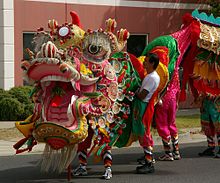
TheBendigo Art Galleryis one of Australia's oldest and largest regional art galleries. In March 2012, it hosted a royal visit fromPrincess Charleneof Monaco at the opening of an exhibition aboutGrace Kelly.[46]
TheCapital Theatre,originally the Masonic temple, is located next to the art gallery in View Street and hostsperforming artsand live music. It also hosts the annual Bendigo Writers Festival which was founded in 2012.
TheUlumbarra Theatre[47]was opened on 16 April 2015.[48]It was originally the Sandhurst/Old Bendigo Gaol. The new theatre which seats nearly 1,000 people sits within the walls and structure of the gaol and retains some original architectural features of the gaol.[49]The venue hosts performing arts and live music. It also acts as a ceremonial and teaching space for local secondary schools and universities.
The city hosts the Bendigo NationalSwap Meetfor car parts every year in early November. It is regarded[by whom?]as the biggest in the Southern Hemisphere and attracts people from all over Australia and the world.
The city hosts the Victorian leg of the annualGroovin' the Moomusic festival. It is held at the Bendigo Showgrounds and is usually held in late April or early May. The festival regularly sells out and brings many Australian and international acts to the city. It also attracts thousands of people from around Victoria to the city for the weekend.
TheBendigo Blues and Roots Music Festivalhas been taking place each November since 2011. With over 80 artists from all over Australia, the not-for-profit festival is hosted in many of the venues around Bendigo, and is headlined by a large, family-friendly, free concert held inRosalind Park.
TheBendigo Easter Festivalis held each year and attracts tens of thousands of tourists to the city over the Easter long weekend. Attractions include parades, exhibitions, and a street carnival.
The Bendigo Queer Film Festival (BQFF) is one of Australia's few regional annual festivals celebrating theQueerfilm genre. The BQFF started in 2004 and takes place in the second half of April.
The Festival of Light is a multicultural celebration of peace and harmony inspired by the Buddha's birthday held in May each year since 2013 at the Great Stupa. The festival's program includes dancing and musical acts followed by a fireworks display at night.
In November 2019 Bendigo was recognised as a United Nations' City of Gastronomy.
Bendigo is home to a number of amateur theatre groups including the Bendigo Theatre Company, Tribe Youth Theatre and Nexus Youth Theatre.
Media
[edit]Bendigo is served by two newspapers: theBendigo Advertiserand theBendigo Weekly,although in October 2019 theBendigo Weeklywas incorporated into theBendigo Advertiserand now features as an insert in the Saturday edition of theAdvertiser.
Eight locally-based radio stations are active; 105.1 Life FM, Gold 1071am and 98.3FM,Hit 91.9,3BO FM,(broadcasting as Triple M) andABC Local Radio,as well as the community radio stations Radio KLFM 96.5,Phoenix FM,Fresh FMand Vision Australia Radio 3BPH Bendigo 88.7 FM.
Network television is broadcast in the Bendigo region by theSeven Network,WIN Television(affiliated with theNine Network),10 Regional(affiliated withNetwork Ten), theAustralian Broadcasting Corporation(ABC) and theSpecial Broadcasting Service(SBS).
Of the three commercial networks, WIN Television airs a half-hourWIN Newsbulletin each weeknight at 5.30 pm, produced from a newsroom in the city and broadcast from studios inWollongong.
Short local news updates and weather updates are broadcast by 10 Regional throughout the day, produced and broadcast from itsHobartstudios. The Seven Network airs short local news and weather updates throughout the day, produced and broadcast from itsCanberrastudios.
On 5 May 2011, analogue television transmissions ceased in most areas of regional Victoria and some border regions including Bendigo and surrounding areas. All local free-to-air television services are now being broadcast in digital transmission only. This was done as part of the federal government's plan fordigital terrestrial television in Australia,where all analogue television transmission were being gradually switched off and replaced withDVB-Ttransmission.
Music
[edit]
A number of live music venues offer local independent bands and artists performing on a regular basis. TheBendigo Town Hallalso hosts music concerts and is a primary venue for the Bendigo Chamber Music Festival. Several adult choirs and the Bendigo Youth Choir often perform overseas; the Bendigo Symphony Orchestra, the Bendigo Symphonic Band, the Bendigo and District Concert Band, several brass bands and three pipe bands perform as well.[50] Musicians originally from Bendigo includePatrick Savage– film composer[citation needed]and former principal first violin of theRoyal Philharmonic Orchestrain London.[51]Australian IdolwinnerKate DeAraugogrew up in Bendigo where her family still live.[52][53]
Sport
[edit]Cricket
[edit]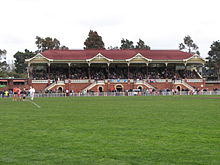
CricketandAustralian rules footballare the most popular sports in Bendigo. TheQueen Elizabeth Oval(referred to locally as the QEO) hosts both sports. The Bendigo and District Cricket Association is the controlling body for 10 senior cricket clubs within the Bendigo area. The Emu Valley Cricket Association organises matches for 13 clubs around the Bendigo district, from Marong in the north to Heathcote in the south. Bendigo is a regional hub for state level sport, hosting numerous Australian Rules Football, Cricket, and other sports competitions annually.
Australian Rules
[edit]In terms of Australian rules,Bendigo Goldwere a semi-professional team which competed in theVictorian Football Leagueuntil 2014. The Bendigo region is also home to the historicBendigo Football League,a strong Australian rules competition featuring 10 teams from throughout the region. One of the league's founding member clubs, the Bendigo-basedSandhurst Football Club,was founded in 1861, making it one of the world'soldest football clubs.
Other Sport
[edit]TheBendigo Cupis a prominenthorse-racingevent.
TheBendigo Stadiumhosted basketball games during the2006 Commonwealth Games.Bendigo's men's team is called theBendigo Bravesand the women's team is calledBendigo Spirit.In both 2013 and 2014, the women's team won theWomen's National Basketball Leaguechampionship. The city co-hosted the2003 FIBA Oceania Championship.
Bendigo was the host to the secondCommonwealth Youth Games,held from 30 November to 3 December 2004 and will also be one of the hosts for the2026 Commonwealth Gamesto be held in regional Victoria.
Bendigo Internastional Raceway, which existed on the Showgrounds, opened as the Golden City International raceway in 1971 and held racing for classes including saloons and stock cars. The venue also hostedmotorcycle speedwayand hosted theVictorian Individual Speedway Championshipin 1995.[54]
Economy
[edit]Bendigo is a large and growing service economy. The major industries are health, finance (headquarters of the Bendigo and Adelaide Bank – Australia's fifth largest bank), tourism, commerce, education, food processing, and primary industries, with some significant engineering industries (see below under "Manufacturing" ).
Bendigo's growth has stimulated growth in small surrounding rural towns (such asElmore,Heathcote,Rochester,Inglewood,DunollyandBridgewater).
Tourism
[edit]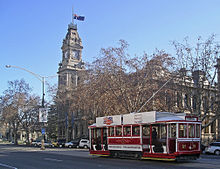
Tourism is a major component of the Bendigo economy, generating over A$364 million in 2008/09.[55]Bendigo is popular withheritage touristsandcultural touristswith the focus of tourism on the city's gold rush history. Prominent attractions include theCentral Deborah Gold Mine,theBendigo Tramways(both of which are managed by the Bendigo Trust, a council-intertwined organisation dedicated to preserving Bendigo's heritage), theGolden Dragon Museum,theBendigo Pottery,and the Great Stupa.
Commerce
[edit]
The main retail centre of Bendigo is the central business district, with the suburbs of Eaglehawk, Kangaroo Flat, Golden Square, Strathdale, and Epsom also having shopping districts.
The city was home to one of Australia's few provincialstock exchanges,theBendigo Stock Exchange(BSX), founded in the 1860s.
The city is the home of the headquarters of theBendigo Bank,established in 1858 as a building society. It is now a large retail bank with community bank branches throughout Australia. The bank is headquartered in Bendigo and is a major employer in the city (it also has a regional office atMelbourne Docklands).
Manufacturing
[edit]The City of Greater Bendigo Community Profile indicated that about 10.2% of the workforce were employed in manufacturing in 2011.[56]After theVictorian gold rush,the introduction of deep quartz mining in Bendigo caused the development of a heavy manufacturing industry. Little of that now remains, but a large foundry (Keech Castings) makes mining, train, and other steel parts and a rubber factory remains (Motherson Elastomers, formerly Empire Rubber).Thales Australia(formerly ADI Limited) is an important heavy engineering company. Australia Defence Apparel is another key defence industry participant making military and police uniforms and bulletproof vests.Intervet(formerly Ausvac) is an important biotechnology company, producing vaccines for animals.
Education
[edit]
TheBendigo Senior Secondary Collegeis the largest VCE provider in the state.Catherine McAuley Collegefollows close after, which ranges from years 7–9 at the Coolock campus and 10–12 at the St Mary's campus.Girton Grammar School,an independent school, provides education to students from years Prep-12. The Bendigo campus ofLa Trobe Universityis also a large and growing educational institution with nearly 5,000 undergraduates and postgraduates.
Farming and agriculture
[edit]The surrounding area, or "gold country", is quite harsh, rocky land with scrubby regrowth vegetation. Thebox-ironbark forestis used for timber (mainly sleepers and firewood) and beekeeping.
Sheep and cattle are grazed in the cleared areas. There are some large poultry and pig farms. Some relatively fertile areas are present along the rivers and creeks, where wheat and other crops such ascanolaare grown. The area produces premium wines, includingShiraz,from a growingviticultureindustry.Salinityis a problem in many valleys,[57][58]but is under control.[59]A relatively smalleucalyptusoil industry operates there.[60][61]
Bendigo provides services (including a large livestock exchange) to a large agricultural and grazing area on the Murray plains to its north.
Gold mining
[edit]One of the major revolutions in gold mining (during the Victorian gold rush) came when fields such as Bendigo, but alsoBallarat,Araratand the goldfields close to Mount Alexander, turned out to have large gold deposits below the superficial alluvial deposits that had been (partially) mined out. Gold at Bendigo was found in quartz reef systems, hosted within highly deformed mudstones and sandstones or were washed away into channels of ancient rivers. Tunnels as deep as 900 m (3000 ft) (Stawell) were possible.[62]
Until overtaken in the 1890s by the Western Australia goldfields, Bendigo was the most productive Australian gold area, with a total production over 622 tonnes (20 million ounces).[63]
Over the 100-odd year period from 1851 to 1954, the 3,600-hectare area that made up the Bendigo gold field yielded 777 tonnes (25 million ounces) of gold.[64]
A large amount of gold remains in the Bendigo goldfields, estimated to be at least as much again as what has been removed. The decline in mining was partly due to the depth of mines and the presence of water in the deep mines.[citation needed]
Infrastructure
[edit]Transport
[edit]
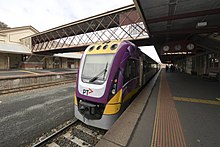
Bendigo is connected via theCalder Freewayto Melbourne, which is fewer than two hours by car.[65]The remaining section of highway nearest Bendigo has been upgraded to dual carriageway standard ensuring that motorists can travel up to speeds of 110 km/h (68 mph) for most of the journey. Many other regional centres are also connected to Melbourne via Bendigo, making it a gateway city in the transport of produce and materials from northern Victoria and the Murray to the Port of Melbourne and beyond.
Bendigo acts as a major rail hub for northern Victoria, being at the junction of several lines including theBendigo linewhich runs south toMelbourneand lines running north including theSwan Hill,EchucaandEaglehawk–Inglewoodlines.V/Lineoperates regularVLocitypassenger rail services to Melbourne with the shortest peak journeys taking approximately 91 minutes fromBendigo railway station,generally however services take two hours or longer. While there are several rail stations in the urban area, only three other stations currently operated for passengers:Kangaroo Flat railway stationon the Bendigo Line,Epsom Railway Stationon the Echuca railway line, andEaglehawk railway stationon the Swan Hill railway line. There are also additional train services to and fromSwan HillandEchuca.TheRegional rail revivalproject will upgrade the Swan Hill and Echuca lines and build three new stations. On the Echuca line, Huntly station (for the outer suburb of Huntly), Goornong Station (A town in greater Bendigo) and on the Swan Hill line Raywood station (A town in greater Bendigo) All set to open between 2021 and 2022. Residents celebrated the opening of the new Goornong Railway Station at a community event on the weekend of 11–12 December 2021.[66]
Victoria's electronic ticketing system,Myki,was implemented on rail services between Eaglehawk and Melbourne on 17 July 2013.[67]
Bendigo is also served by an extensive bus network that radiates mostly from the CBD with the main terminus at the railway station towards the suburbs. The city is also served by several taxi services.
Trams in Bendigohave historically operated an extensive network as a form of public transport, but the remains of the network were reduced to a tourist service in 1972.[68]Short trials of commuter tram services were held in 2008 and 2009 with little ridership. The second, "Take a Tram", proved more successful, running twice as long as the previous trial. By the end of the "Take a Tram" program, ridership had increased and was increasing. However, due to lack of government subsidy or backing, the program ended.[69]
Bendigo is served by theBendigo Airport,which is located to the north of the city on theMidland Highway.The Bendigo Airport Strategic Plan was approved in 2010 for proposed infrastructure upgrades including runway extension and buildings to facilitate larger planes and the possibility of regular passenger services from major cities in other states. In 2016, Bendigo Airport was upgraded with a new taxiway system, new lighting, and a new 1.6-km north–south runway. On 10 December 2018,Qantasannounced that they would fly between Sydney and Bendigo six times a week, the first of which commenced on 31 March 2019.[70]
Health
[edit]TheBendigo Base Hospitalnow known as Bendigo Health is the city's largest hospital, only public hospital, and a major regional hospital. St John of God is the largest private hospital. Bendigo is also served by a privately owned smaller surgical facility, the Bendigo Day Surgery.[citation needed]
Utilities
[edit]Bendigo is entitled to a portion of the water inLake Eppalock,an irrigation reservoir on theCampaspe River.Developments have led to the building of a pipeline fromWarangato Lake Eppalock and thence to Bendigo in 2007. In 1858 Bendigo water works hiredJoseph Bradyas an engineer and he designed nine reservoirs and a channel system called theColiban main channelwhich provides water from theMalmsburyreservoir to customers in central Victoria.
Sister cities
[edit]Notable residents
[edit]Arts and entertainment
- Harold Desbrowe Annear,architect
- Bunney Brooke,TV actress
- Amy Castles,singer[72]
- Ola Cohn,sculptor
- Kate DeAraugo,2005Australian Idolwinner
- Colleen Hewett,singer and actress
- Russell Jack,founder of theGolden Dragon Museum
- Sam Jinks,sculptor
- Roger Kemp,artist
- Victor Kennedy,writer and journalist
- Keith Lamb,lead singer ofHush
- Sarah McKenzie,jazz singer, pianist, and composer
- Ernest Moffitt,artist
- William Moore,art and drama critic
- William David Murdoch,concert pianist
- John Bernard O'Hara,poet and schoolmaster
- Alfred Henry O'Keeffe,artist
- Pollyfilla,drag performer and costume designer
- Ian Rilen,bass guitarist withRose Tattoo
- Virginia Trioli,journalist and television host
- Christian Waller,artist
- Lincoln Younes,actor
Business
- Herbert Robinson Brookes,businessman, pastoralist, public official and philanthropist
- Fletcher Jones,Australian entrepreneur
- Frank McEncroe,inventor of theChiko Roll
- Sidney Myer,philanthropist and founder of the Myer chain of department stores
- Thomas Flanagan,co-founder ofKalgoorlie,Western Australiain June 1893
Military
- SirGilbert Dyett,long-serving president of theReturned and Services League of Australia
- Carl Jess,Australian ArmyLieutenant General
- John Campbell Ross,last Australian World War I veteran
Politics
- Jacinta Allan,LaborPremier of Victoria,2023–
- John Bannon,LaborPremier of South Australia,1982–1992
- Noel Beaton,LaborFederal Member for Bendigo 1960–69, Shadow Minister for Primary Industries 1967–69
- Frank Brennan,FederalAttorney-General,1929–31
- Tom Brennan,older brother of Frank and FederalUAPSenator,1931–37
- John Brumby,LaborPremier of Victoria,2007–2010
- Daryl McClure(1947–2015) wasLiberalmember for Bendigo in theVictorian Legislative Assembly,1972–1982
- Rod Fyffe(1949-2024), former mayor of Bendigo
- John Gunn,LaborPremier of South Australia,1924–26
- Edward Heitmann,FederalLaborpolitician, 1917–1919
- John Lutey,Labor Partymember of theWest Australianparliament, 1917–1932
- SirJohn Quick,Protectionist PartyMP for Bendigo, 1901–1913. Knighted on 1 January 1901 for his contribution to Federation
- John Stanistreet(1913–1971) wasLiberal Country PartyVictorian Legislative AssemblyMember for Bendigo 1955–1958
- Maxwell John "Max" Turner(born 12 February 1947) is a former Member for Bendigo West (1992–1996)
- Nicholas Bruce Reid(30 July 1935 – 24 May 2020) was an Australian politician.
- Peter Ryan,former leader of theVictorianNational Party
Religion
- Sydney James Kirkby,Anglicanbishop
- Thomas Cahill,Roman Catholicbishop
Science
- Martha Durward Farquharson,hospital matron
- John Irvine Hunter,professor ofanatomy
- Frank Milne,professor of economics
- Struan Sutherland,antivenom researcher
- Geoffrey Watson,professor of statistics
- Kirby White,general practitioner
Sport
- Australian Football Leagueplayers:Jim Mooring,Nathan Brown,Wayne Campbell,Nick Dal Santo,Jake Stringer,Eric Fleming,Trevor Keogh,Barry Mulcair,Troy Selwood,Adam Selwood,Joel Selwood,Scott Selwood,Geoff Southby,Colin Sylvia,Brian Walsh,Greg Williams
- Ben Hunt,NCAA and NBL basketball player
- Billy Murdoch,AustralianTest cricketcaptain
- Chris Hamilton,professional cyclist
- Christine Envall,professional bodybuilder
- Craig White,English cricket player
- Don Blackie,Test cricketer
- Dyson Daniels,NBAbasketball player
- Faith Leech,Olympic swimming champion
- Glen Saville,Australian and NBL basketball player
- Hannah Every-Hall,rower
- Kristi Harrower,Olympic basketball player
- Lisle Nagel,AustralianTest cricketer
- Rhein Gibson,PGA Tour Golfer and Guinness World Record holder for lowest golf round ever (55)
- Ricky Nixon,sports agent and former AFL footballer
- Sam Irwin-Hill,NFLpunter
- Sharelle McMahon,Australian Netball Team captain, Melbourne Vixens captain
- Stephen Huss,2005Wimbledonmen's doubles champion
See also
[edit]- List of mayors of Bendigo
- Bendigo Easter Festival
- Bendigo South East College
- Crusoe Secondary College
- Great Stupa of Universal Compassion
- Flora Hill Secondary College
- Golden Square Secondary College
- HM Prison Bendigo
- Sun Loong
- Victory Christian College
- Violet Street tram stop
- 2003 Bendigo tornado
- Ulumbarra Theatre
References
[edit]Citations
[edit]- ^"2021 Bendigo, Census All persons QuickStats".Australian Bureau of Statistics.Retrieved28 June2022.
- ^"3550 Postcode".Australia Post.Australia Post.Retrieved2 April2024.
- ^"2016 Census Community Profiles: Bendigo".ABS Census.Australian Bureau of Statistics.Retrieved26 October2017.
- ^Plaque to mark Exact Centre of Victoria - 12/10/2006City of Greater Bendigo
- ^Statistics."Population estimates by LGA, Significant Urban Area, Remoteness Area and electoral division, 2001 to 2022".abs.gov.au.Australian Bureau of Statistics.Retrieved23 January2024.
- ^"Our region | City of Greater Bendigo".bendigo.vic.gov.au.Retrieved16 December2023.
- ^"Djaara (Dja Dja Wurrung Clans Aboriginal Corporation)".Retrieved1 June2021.
- ^abWelcome to the City of Greater Bendigo population forecastsCity of Greater Bendigo
- ^Clark, Ian D. (1995).Scars in the landscape: a register of massacre sites in western Victoria, 1803-1859.Canberra: Australian Institute of Aboriginal and Torres Strait Islander Studies.ISBN0-85575-281-5.OCLC41539940.
- ^Beth Gott, ‘Murnong — Microseris scapigera: a study of a staple food of Victorian Aborigines’, Australian Aboriginal Studies, no. 2, 1983, pp. 12, 14.
- ^The Squatters' directory: Containing a list of all the occupants of crown lands in the intermediate and unsettled districts of Port Phillip... compiled from the Government Gazette... (1849). Melbourne: Edward Wilson.
- ^Strachan, H. M. (1932), Foreword,Pastoral pioneers of Port Phillip,by Billis, R. V. (Ralph Vincent); Kenyon, A. S. (Alfred Stephen), 1867-1943, Macmillan & Company Ltd.,retrieved26 June2020
{{citation}}:CS1 maint: multiple names: authors list (link) CS1 maint: numeric names: authors list (link) - ^"The Bendigo Independent (Vic.: 1891 - 1918) - 10 Apr 1917 - p2".Trove.Retrieved26 June2020.
- ^ab"THE BENDIGO ADVERTISER".Bendigo Advertiser.Vol. XXXV, no. 10, 156. Victoria, Australia. 21 March 1888. p. 2.Retrieved26 June2020– via National Library of Australia.
- ^abLawrence, Susan; Davies, Peter (2019).Sludge: disaster on Victoria's goldfield(1st ed.). Carlton, Victoria: La Trobe University Press in conjunction with Black Inc.ISBN9781760641108.OCLC1101283189.
- ^Chen, Lovell (2013).Thematic environmental history: final report June 2013.Lovell Chen.OCLC1228917606.
- ^Morrison, Edgar (1981).The Loddon Aborigines: tales of old Jim Crow.OCLC271522680.
- ^James, Ken (2009)."The surveying career of William Swan Urquhart, 1845-1864 | PROV".Provenance: The Journal of Public Record Office Victoria, issue no. 8, 2009. ISSN 1832-2522.Retrieved25 June2020.
- ^"IBA: Bendigo Box-Ironbark Region".Birdata.Birds Australia. Archived fromthe originalon 6 July 2011.Retrieved23 October2011.
- ^Porteners, M. F. 1993.The natural vegetation of the Hay Plain: Booligal-Hay and Deniliquin-Bendigo 1:250 000 maps, Cunninghamia Vol. 3(1): 1–87.
- ^Donohue, R. J., McVicar, T. R., and Roderick, M. L.: Climate-related trends in Australian vegetation cover as inferred from satellite observations, 1981–2006, Glob. Change Biol., 15, 1025– 1039, 2009
- ^ab"Bendigo Campus, Latrobe".AtUni.au. 20 June 2014. Archived fromthe originalon 2 April 2015.Retrieved31 March2015.
- ^"The exceptional January–February 2009 heatwave in south-eastern Australia"(PDF),Bureau of Meteorology,National Climate Centre, p. 2, 12 February 2009
- ^Aikman, Rod (8 February 2003)."Weather history preserved".Bendigo Advertiser.Retrieved5 August2011.
- ^"Climate statistics for Bendigo".Bureau of Meteorology. April 2023.Retrieved4 April2023.
- ^The Argus(Melbourne) 30 May 1859, p. 6.
- ^The Courier(Hobart, Tas.) 20 May 1859, page 2
- ^The Argus(Melbourne) 29 December 1903, p. 6.
- ^"'Mini tornado' wreaks havoc ".The Age.Melbourne. 19 May 2003.Retrieved30 March2008.
- ^Permanent Water Saving RulesColiban Water
- ^ab"Meeting held for fire-affected Bendigo residents".Australian Broadcasting Corporation. 9 February 2009.Retrieved9 February2009.
- ^Power, Emily; Collier, Karen (9 February 2009)."The man up the road is on fire".Herald Sun.Australia. Archived fromthe originalon 30 December 2012.Retrieved9 February2009.
- ^Quirk, Clare (7 March 2010)."Bendigo flood clean-up, then the cost".Bendigo Advertiser.Retrieved31 March2015.
- ^Quirk, Clare (5 September 2010)."Deluge causes flood havoc across central Victoria".Bendigo Advertiser.Retrieved31 March2015.
- ^abAustralian Bureau of Statistics(27 June 2017)."Bendigo (Urban Centre and Localities)".2016 Census QuickStats.Retrieved22 April2018.
- ^abc"Religion | City of Greater Bendigo | Community profile".profile.id.au.Retrieved29 June2020.
- ^"One of Australia's oldest Chinese temples brings fortune and family, worshippers say".abc.net.au/. 18 February 2018.Retrieved22 November2020.
- ^National Trust of Australia (Vic.); National Trust of Australia (Victoria) (1972),Bendigo and the Chinese Joss House,National Trust of Australia (Victoria),ISBN978-0-909710-04-0
- ^abRomensky, Larissa (26 July 2019)."Bendigo mosque construction begins as Premier Daniel Andrews turns first sod".ABC News.Australian Broadcasting Corporation.Retrieved29 March2021.
- ^Patrick, Hatch."Q Society spreading anti-mosque message in Bendigo".The Age.Retrieved27 August2014.
- ^Morris, Madeleine (12 October 2015)."Bendigo's anti-mosque protest: United Patriots Front nationalist group behind demonstration".ABC News.Retrieved29 March2021.
- ^Kernebone, Elspeth (26 July 2019)."Bendigo mosque works begin as first sod turned at site of Islamic Community Centre".Bendigo Advertiser.Retrieved29 March2021.
- ^"Vienna Of The South" (Bendigo), VicAustralia for Everyone
- ^Pallin, Nancy; McDonald, Tein (January 2013)."On-ground habitat restoration: Interview with Nancy Pallin".Ecological Management & Restoration.14(1): 11–19.doi:10.1111/emr.12029.ISSN1442-7001.
- ^Roberts, Billie J.; Mo, Matthew; Roache, Mike; Eby, Peggy (2020)."Review of dispersal attempts at flying-fox camps in Australia".Australian Journal of Zoology.68(6): 254.doi:10.1071/zo20043.ISSN0004-959X.
- ^John Elder."A fairytale in Bendigo as Charlene enters with grace".The Age.Retrieved31 March2015.
- ^"Home".Ulumbarra Theatre.Retrieved20 January2016.
- ^Pedler, Chris (17 April 2015)."Ulumbarra Theatre: Grand opening kicks a goal".Bendigo Advertiser.Retrieved20 January2016.
- ^Parker, Fiona (19 January 2015)."Old meets new in Bendigo as Sandhurst Gaol becomes Ulumbarra Theatre – ABC News (Australian Broadcasting Corporation)".Abc.net.au.Retrieved20 January2016.
- ^"Arts Register".City of Greater Bendigo.2010. Archived fromthe originalon 8 October 2009.Retrieved6 June2010.
- ^Moore, Debi (26 August 2010)."Sample a Bit of the Score from Fetch".Dreadcentral.Retrieved31 March2015.
- ^"Celebrity – Book Kate Dearaugo at MTA – Entertainment Booking Agency Australia – MTA Entertainment and Events".Musictheatreaustralia.au. 5 November 1985.Retrieved31 March2015.
- ^"Kate Dearaugo Biography".Sing365. Archived fromthe originalon 2 April 2015.Retrieved31 March2015.
- ^"Bendigo (Vic)".Speedway and Road Race History.Retrieved25 February2024.
- ^"Bendigo Tourism Board Inc: Annual Report: 2008–2009"(PDF).121.50.208.46. Archived fromthe original(PDF)on 4 March 2016.Retrieved31 March2015.
- ^"Industry sector of employment | City of Greater Bendigo".Profile.id. 10 January 2011.Retrieved31 March2015.
- ^Edwards, M. D., & Webb, J. A. (2003, November). Ground-Truthing of a Tempest Airborne Electromagnetic Survey in the Salinised Kamarooka Catchment, Near Bendigo in Central Victoria. In Proceedings CRC LEME Regional Regolith Symposium, Adelaide (pp. 110-114)
- ^Lane, R., Heislers, D., & McDonald, P. (2001). Filling in the gaps? validation and integration of airborne EM data with surface and subsurface observations for catchment management? an example from Bendigo, Victoria, Australia. Exploration Geophysics, 32(4), 225-235.
- ^Reid, M. (1995, September). Burkes Flat—a salinity treatment success story. In Murray-Darling Basin Groundwater Workshop’. Wagga Wagga, NSW (unpublished)
- ^McCartney, W. T. (2003). An introductory overview of the essential oil industry in Australia. In Proceedings of International Federation of Essential Oils and Aroma Trades international conference’.(Ed. C Green)[CD-ROM](IFEAT: London).
- ^Goodger, J. Q., Heskes, A. M., King, D. J., Gleadow, R. M., & Woodrow, I. E. (2008). Micropropagation of Eucalyptus polybractea selected for key essential oil traits. Functional Plant Biology, 35(3), 247-251.
- ^Ferguson, AMJ (27 October 2022).Gold, Gems and Pearls in Ceylon and Southern India.London,John Haddon & Co.p. 283.ISBN978-1-01-679788-7.URL:Gold, Gems, Pearls Ceylon, Australian Gold Fields Discussion
- ^Craig (28 April 2023)."Things to Do In Bendigo In 2023 | Your Ultimate Guide".Finder Hub.Retrieved30 April2023.
- ^"State of Victoria Early Postal Cancels (and History) Illustrated, Section II: 1851 to 1853"(PDF).Home cast.net. Archived fromthe original(PDF)on 2 November 2013.Retrieved31 March2015.
- ^Google Maps calculates the distance from Bendigo to Melbourne to be 153 km (95 mi) and the time of travel is estimated to be 1 hour 47 minutes.
- ^"Trains arrive to put Goornong back on track for good times".Railpage.Retrieved15 December2021.
- ^"Myki to start on VLine Commuter Services".VLine Pty Ltd. Archived fromthe originalon 27 August 2013.Retrieved7 August2013.
- ^"The Bendigo Trust".bendigotrust.au. Archived fromthe originalon 17 June 2008.Retrieved7 June2008.
- ^"Tram trial gets mixed results"(PDF).Tram Talk.Friends of the Bendigo Tramways. 2009.Retrieved7 July2010.
- ^Bendigo Airport Strategic PlanCity of Greater Bendigo June 2009
- ^ab"Sister Cities".City of Greater Bendigo.Archived fromthe originalon 19 February 2011.Retrieved1 November2010.
- ^"Another Australian Singer".Newcastle Morning Herald and Miners' Advocate.No. 10, 393. New South Wales, Australia. 29 February 1908. p. 16.Retrieved6 April2022– via National Library of Australia.
Sources
[edit]- Sarle, Geoffrey. "Mackey, Sir John Emanuel (1863–1924)".Australian Dictionary of Biography, Volume 10, (MUP), 1986.Australian Dictionary of Biography.Retrieved30 March2015.

